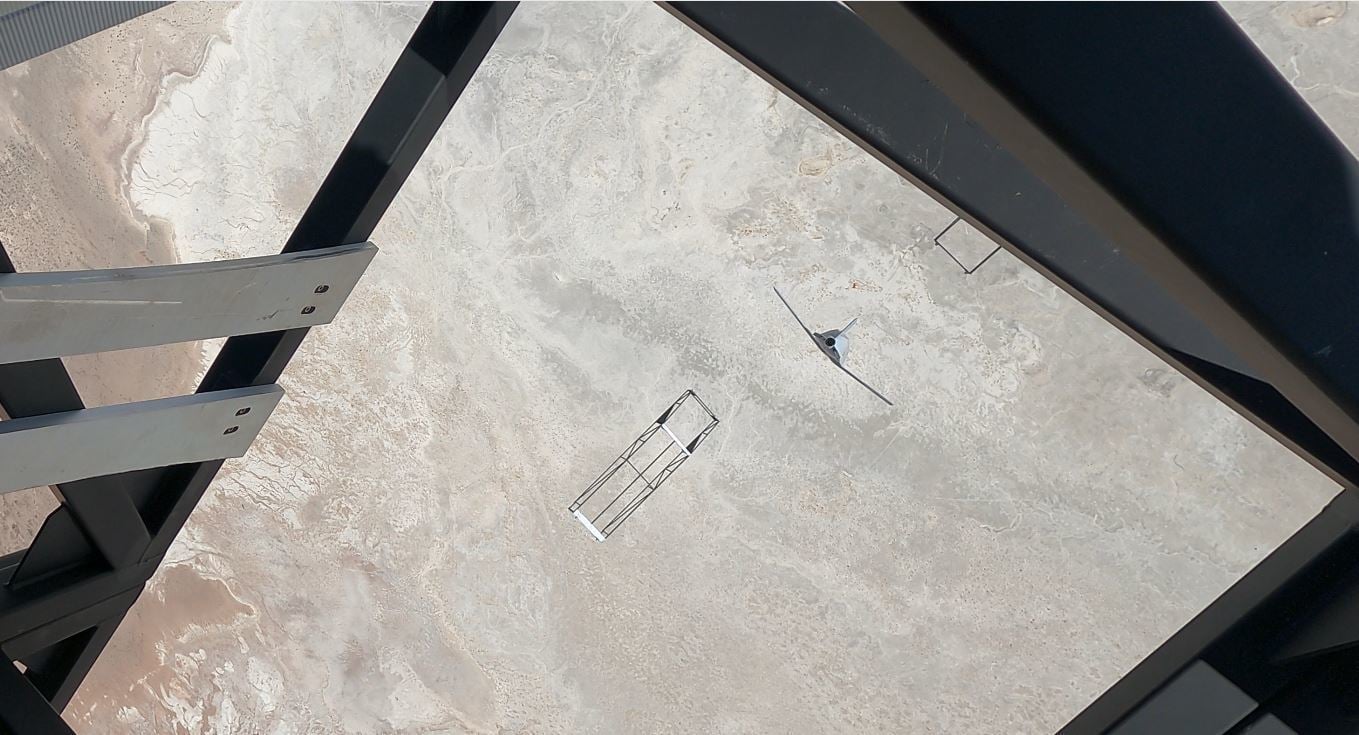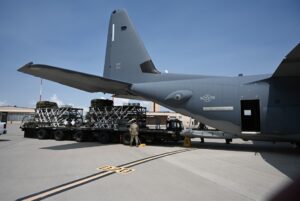
During a Nov. 3, 2021 test of the Air Force’s Rapid Dragon concept, an unarmed cruise missile deployed from a pallet airdropped by an MC-130J. (US Air Force)
WASHINGTON: Next month the Air Force will conduct a capstone exercise for a program aiming to turn cargo planes into aerial bomb trucks, when a standard-looking pallet will be airdropped out of an MC-130J and launch a live cruise missile as it parachutes down through the air.
The demonstration will wrap up the first phase of the Air Force’s Rapid Dragon program, the service’s effort validating its “palletized munitions” concept, Dean Evans, the service’s Rapid Dragon program manager, told Breaking Defense today.
In the early stages of a war with a sophisticated adversary like China, the Air Force believes the number of airstrikes being traded will make it difficult for airlift platforms to move people and equipment into threat zones. Further, the service has hypothesized that it may need even more strike capacity than it currently has with its fleet of fighters and bombers.
“The ability to cost-effectively deliver long-range standoff weapons en masse from non-traditional platforms expands warfighting flexibility and introduces new deterrence options,” Evans said.
Or as Lt. Gen Clint Hinote, the Air Force’s futurist, put it last year: “What we see is that no matter how big our bomber force is, the capacity that the joint force needs is always more and more.”
That’s where palletized munitions for airlift assets like cargo planes come in. The thinking is that the service can create a “smart pallet” that looks like the standard pallets used to roll equipment on and off aircraft like the C-130 or C-17, but can feed targeting and launch command information to the guided munitions contained inside of it.
After that pallet is airdropped from a cargo plane and begins its fall to the ground, the pallet would then launch multiple munitions, each intended for different targets and timed to safely separate from each other.
Most recently, the program conducted a successful flight demonstration Nov. 3 at White Sands Missile Range, N.M., where an MC-130J airdropped a pallet containing a long range cruise missile separation test vehicle — basically a cruise missile without an engine or warhead.

U.S. Air Force personnel load a Rapid Dragon deployment system onto an MC-130J aircraft ahead of an airdrop. (US Air Force)
According to an Air Force Research Laboratory news release, the MC-130J crew received targeting data from a beyond-line-of-sight node and then transferred that information from the aircraft’s onboard Battle Management System to the cruise missile test vehicle. The event was the first time that upload of data occurred with an unarmed cruise missile instead of an emulator, AFRL said.
Then, the MC-130J dropped a four-cell Rapid Dragon palletized system from its cargo bay. As the pallet was parachuting down, it sequentially launched the cruise missile test vehicle and three “mass simulants,” which replicate the weight and shape of a cruise missile. The cruise missile test vehicle deployed its wings and tail seconds after release, began pulling up and then glided toward its target.

An airdropped Palletized Munition Deployment System carrying an unarmed cruise missile test vehicle, shown here immediately after being airdropped from an MC-130J during a Nov. 3, 2021 test. (US Air Force)
A demonstration planned for December will use a live cruise missile instead of an unarmed test vehicle and will conclude the first, developmental stage of the program, Evans said.
“The plan is to mature the capability from a developmental prototype to an operational prototype in the next phase,” which will begin next month immediately following a successful demonstration, Evans said. “We will be integrating additional weapons/effects in the next phase of Rapid Dragon” and will test the pallet deployment system’s ability to safely launch multiple weapons, he said.
The Nov. 3 demonstration was performed by an operational Air Force Special Operations Command aircrew, AFRL stated. Other participants included Naval Surface Warfare Center-Dahlgren; Standoff Munitions Application Center; Lockheed Martin Missiles and Fire Control; Systima Technologies; and Safran Electronics & Defense, Parachutes USA.
Last year, Lockheed Martin received a $25 million contract for further work on the Rapid Dragon program. At the time, Scott Calloway, Lockheed’s program director, told reporters its roll on/roll off smart pallet could be configured to carry up to 32 AGM-158B JASSM-ER (Joint-Air-to-Surface Standoff Missile-Extended Range) missiles on a C-17.






















